SVALBARD - EIGHT DAYS IN THE ICE PARADISE
The Svalbard Islands are located in the Arctic Ocean, halfway between Norway and the North Pole and are the northernmost inhabited lands on planet Earth.
Photodiary of eight days spent in May on a small boat, navigating the ice beyond the 78th parallel, never seeing the sun setting, looking for polar bears, walruses, seals and all arctic animals, surrounded only by ice and from the wonders of nature.
A total immersion without any connection with the world, but with a very strong connection with a unique, remote and magical place where man feels small and humble compared to the untouched and majestic nature that here is regulated by the slow rhythm of time and its fragile balances.
DAY 1 - DEPARTURE
The day of departure is always unique. Emotions, ideas, programs, everything in the head is spinning and the whole body is saturated with positive energy.
In the afternoon a boat awaits us and above all eight days of Arctic await us. What's going to be out there? What will we see? What animals will we meet? Many questions, but no expectations. Only the certainty that every day is unique and different and so will the next few days too. It will be unique to live eight days in this unique and remote part of the world with twenty-four hours of sunshine a day, and all we will see, all the encounters we will have, will be unique and wonderful.
Let's start from Longyerbayen, the northernmost inhabited place on planet earth. There are no other cities or towns permanently inhabited by man beyond this latitude. Everything that appears at this latitude, 78 ° and 13 ° to be exact, deserves the nickname of "the most northerly in the world".
These places are always full of charm and make you travel back in time with your mind. They remind us of the first miners who settled here and who founded the village in the early years of the last century and how they could live and work in these temperatures, without the equipment and clothing we have now. Other times and other tempers, certainly other men.
To try to better understand where we are, we pay a visit to the two museums in the town, very beautiful and explanatory on the history, fauna and geography of the island and above all on the history of the first expeditions to conquer the north pole.
We spend the rest of the morning walking around the village and after the last purchases and preparations we are ready to embark and leave for this unique adventure.
The MV Villa awaits us at the dock, a former work boat for laying buoys converted into an expedition boat. The choice of doing this adventure with a small boat was made for various reasons. High cruising speed to cover as much space as possible, the ability to break the ice, few people on board and maximum speed and independence to go ashore quickly with the zodiacs. In addition, the height of the bridge from the water and ground level allows you to take good photos even from above the boat.
We are twenty on board: eight passengers, four guides, eight crew members, all of different nationalities. There are Italy, Norway, Germany, Sweden, Finland, England, Spain, France, Switzerland, South Africa, Argentina, Canada. Really incredible and strange, but not too much because it is the same for all Svalbard. I am in Norway, but they are practically everyone's island and where everyone from all over the world can come, move, live and work, without the need for a visa or permit. The Svalbard community is exceptional and one of a kind. It is a multicultural society in which different ethnic groups and cultures coexist peacefully and the stories of the people who have chosen to live here are always interesting and over the line.



A short introductory briefing on safety and general rules of life on a boat, then in the late afternoon we leave the port of Longyerbayen to explore the Arctic. We are finally sailing in the Arctic and after a few hours of navigation we already have our first sighting. Far away on the coast is a moving dot that is noticeable as it is slightly more yellow in color than the white of the snow and ice; our first sighting is of a polar bear.
After a brief consultation with the Captain we decide to get as close to the shore as possible and to spend the evening and also the night here. Night only for the clock because the sun never sets and so we decide to go with the zodiacs to get as close as possible to our bear. It is 10 pm, we left a few hours ago and we are already on a zodiac between the cold wind and the icy waves of the Arctic Sea.
We head towards the bear, but the ice sheets present do not allow us to get too close. It is distant, but the view is still good and even if far away we have the first shots of a polar bear on the Arctic quay. A white bear surrounded by ice. A white bear in its natural and unique habitat, that habitat which is slowly disappearing due to climate change and which puts the future of this splendid animal at risk.
The cold wind hits the whole body hard and we decide to get back on board, but we quickly change our minds. The emotions are not over because further away we spot another bear. We are looking for a way to get closer and this time it is much better because we manage to find a space between the ice sheets. We evaluate the direction of the bear and try to anticipate the area where it will pass, arriving with the zodiac to lean on the ice of the pack ice. The idea is excellent as in a short time the bear passes in front of us at a much closer distance than the previous one. We admire it and take the shots that we manage as the fingers freeze so much that they seem to break and every now and then we are forced to stop to warm them. The bear looks at us curiously and continues its walk on the polar ice in search of seals and food.
Less than two percent of their hunt is successful. Although about half of a polar bear's life is spent hunting for food, this activity is rarely successful. Seals are the main prey of the polar bear, which also feeds on reindeer, cetacean carcasses, small mammals, birds and eggs. The large size makes this animal the largest terrestrial carnivore on the planet; it is at the top of the food chain among the animals of the North Pole and plays an essential role in the entire ecosystem of the Arctic Circle.
The bear definitively walks away on the ice with incredible method and lightness for an animal that can weigh up to seven hundred kg. They know ice well and understand its thickness from its color. If the ice is white they can walk calmly, while based on the shades of gray they know that it is better to be careful about how to move. With their forelegs they test the tightness of the ice and, if necessary, they do not rest their hind legs and drag them leaning on their stomachs.
To follow and photograph the bear with the zodiacs, we moved a long way from our boat and the return is definitely challenging. The sea is rough and the splashes of water that freeze on us put a strain on our technical clothing and especially our bodies. We finally arrive at the boat, wet, frozen, tried, but full of emotions with the first day of the Arctic which has already given us two sightings of polar bears.
We dry up, drink hot tea and get into bed exhausted, but happy.
We look at the clock and it is two in the morning. Between all these situations and emotions Time has passed incredibly fast, as it always does when emotions are so intense. Indeed, in this magical place, time as we count it and consider it does not even exist….
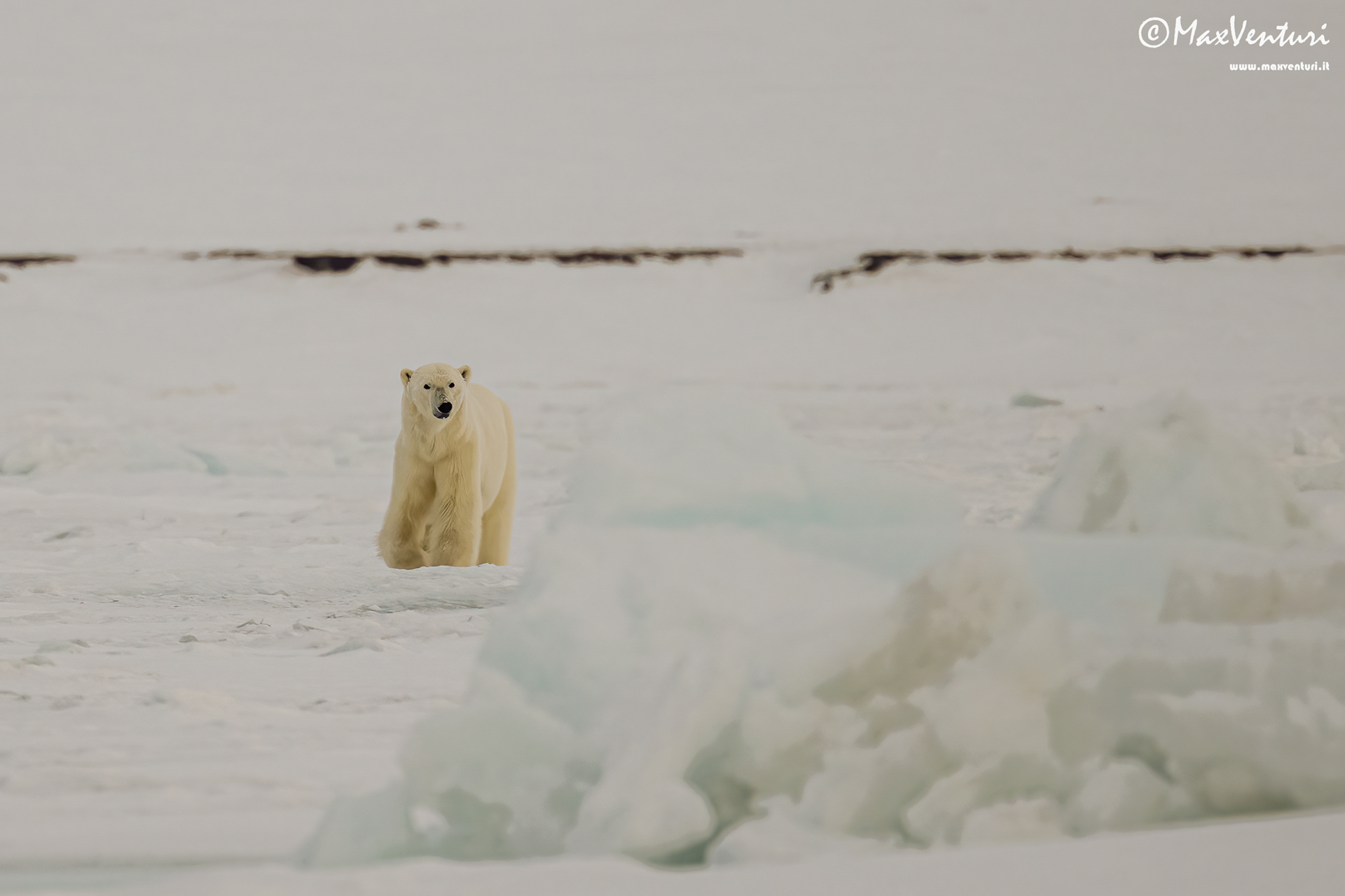

DAY 2 - THE ICE
Wake up late this morning after going to sleep late, with the image of the polar bear still running in front of us in our eyes and mind. Let's take a quick look in the camera display at the photos from the previous night to be sure it wasn't a dream of the night and we're ready to see what the day will bring.
The boat is already moving and we understand that we are entering a fjord from the sound of the ice breaking against the hull as the closer we get to the coast the more the ice increases. While we are sailing we meet some walrus lying on the ice that dives into the sea when the boat enters its safety zone. On the coast in the distance, reindeer can be seen looking for some frozen blade of grass to eat in the few areas uncovered by the snow.
Most of Svalbard, especially in this period, is covered by ice. As a result of the average annual temperature, the soil is permanently frozen, and thaws in summer only for a small depth, so as to allow only the summer vegetation of a light grassy mantle at low altitude, in sunny places and not exposed to cold winds. . In the Svalbard islands there are no trees, but only mosses, lichens, small bushes and flowers scattered here and there to defy the cold and the wind.
The day is beautiful. The sun illuminates everything, warms our souls and even our bodies and allows us to be outdoors on the deck while sailing.
With the boat breaking the thinnest part of ice we enter the fjord as much as possible until the ice allows it and on the coast, in the distance, we spot a polar bear. We get ready, we organize ourselves to get closer and in a moment we are at sea on the zodiacs. Unfortunately the bear has other ideas and decides to move away and when we arrive in the area he has already gone over the mountain. We still enjoy the zodiac trip along the coast, seeing the tracks of the bear in the snow and also the remains of a reindeer that was a recent meal. The captain calls us by radio and tells us to come back quickly as the ice behind the boat is closing and if we are late in leaving we could have problems getting out of the fjord with the risk of getting stuck.
Let's go back on board and leave the fjord breaking the ice sheets, many polygons that together form a perfect geometric design, perfect like all the things that nature creates and offers us.
We set sail to the south, we will sail all night and tomorrow morning we will reach Hormsund, where a zodiac ride awaits us near the majesty of a glacier with the usual search for encounters and everything that the Arctic will decide to give us.
DAY 3 - THE ICEBERGS
The night at sea was quite eventful. The rough sea lulled us to sleep, but dropped some things. The cabin of the boat is very comfortable and convenient, but we are still on a boat sailing in the Arctic and the sea has reminded us of this and has not forgiven us for the mistake of leaving a glass and other things on the table. Mistakes are also called experiences and of course we will not leave anything on the table anymore.
Immediately in the morning we go out with the zodiac for an excursion. We are near a glacier and obviously the sea is mostly covered with ice. With the zodiac we make our way through the smaller ice sheets and navigate where we can until we arrive where the ice is compact and it is no longer possible to continue. While we are looking for a way to get closer to the glacier we see some walruses lying on the ice in the sun in the distance and we decide to dedicate ourselves to them. We approach slowly first with the engine idling and then to avoid disturbing them we turn it off and use the oars. There are five examples and they continue to do nothing. They lie in the sun, move their heads from time to time to look at us, emit a few grunts and simply enjoy the warmth of the sun, life and the passage of time. Documentaries obviously always show us animals in activity, but in reality all animals spend most of their time doing absolutely nothing, simply enjoying the great gift of existing. We take a few shots, greet them and continue the zodiac excursion through the ice, so entranced by the environment that we have everything around us that we feel like we are in a dream.
A dream tinged with blue like the ice that surrounds us endlessly, with green and turquoise floating icebergs that sink into the glacial sea. At Svalbard White offers a myriad of all different shades. The sun comes straight into the eyes and illuminates the white in various and magnificent shades. The sun's rays pass through the clouds and snow and ice as if by magic light up with a thousand colors. A unique show that envelops us, pampers us and welcomes us without conditions.
The search for other animals ends unsuccessfully and we return to the boat to recharge the physical energies and the batteries of the cameras. We resume navigation to the south and after a few hours we arrive at the southernmost end of the island. In this area, due to currents and winds, large icebergs are concentrated more, huge blocks of ice that emerge from the sea and hide their largest part below the water level. Icebergs are fragments detached from millenary glaciers and are composed of fresh water. Inside they have ice and air bubbles formed thousands of years ago and completely change the measure and perspective of time. They make us think about how useless our concept of time is and how even the entire life of a human being is nothing compared to the existence of these places, comparable to a crystal of frozen water inside one of these huge icebergs.
During a trip to Svalbard, man feels small and humble compared to the untouched and majestic nature that is regulated here by the slow rhythm of time and its fragile balances.
However, the clock is part of our concept of time and tells us that it is evening. The evening light and the wonder around us is so great that we decide to go down again with the zodiacs for another close excursion among the icebergs. While we admire the icebergs and look for some wild creatures among the large blocks of ice the low sun creates a large orange stripe under the clouds and in addition to making the ice in that direction of yet another spectacular dark gray color, it also gives us the idea of have a sunset, which obviously will never come this time of year.
We still sail for a few hours looking for other photographic opportunities of Arctic fauna, but without success and when it is now midnight we return to the boat.
We are exhausted and cold, the frozen hands with difficulty respond to the head and make all common operations difficult. Being able to take off everything we have on, washing and settling down for the right rest is a long and difficult operation, but we succeed.
We lie down exhausted and saturated with emotions and beauty and fall asleep lulled by the boat which has in the meantime resumed navigation towards the north.


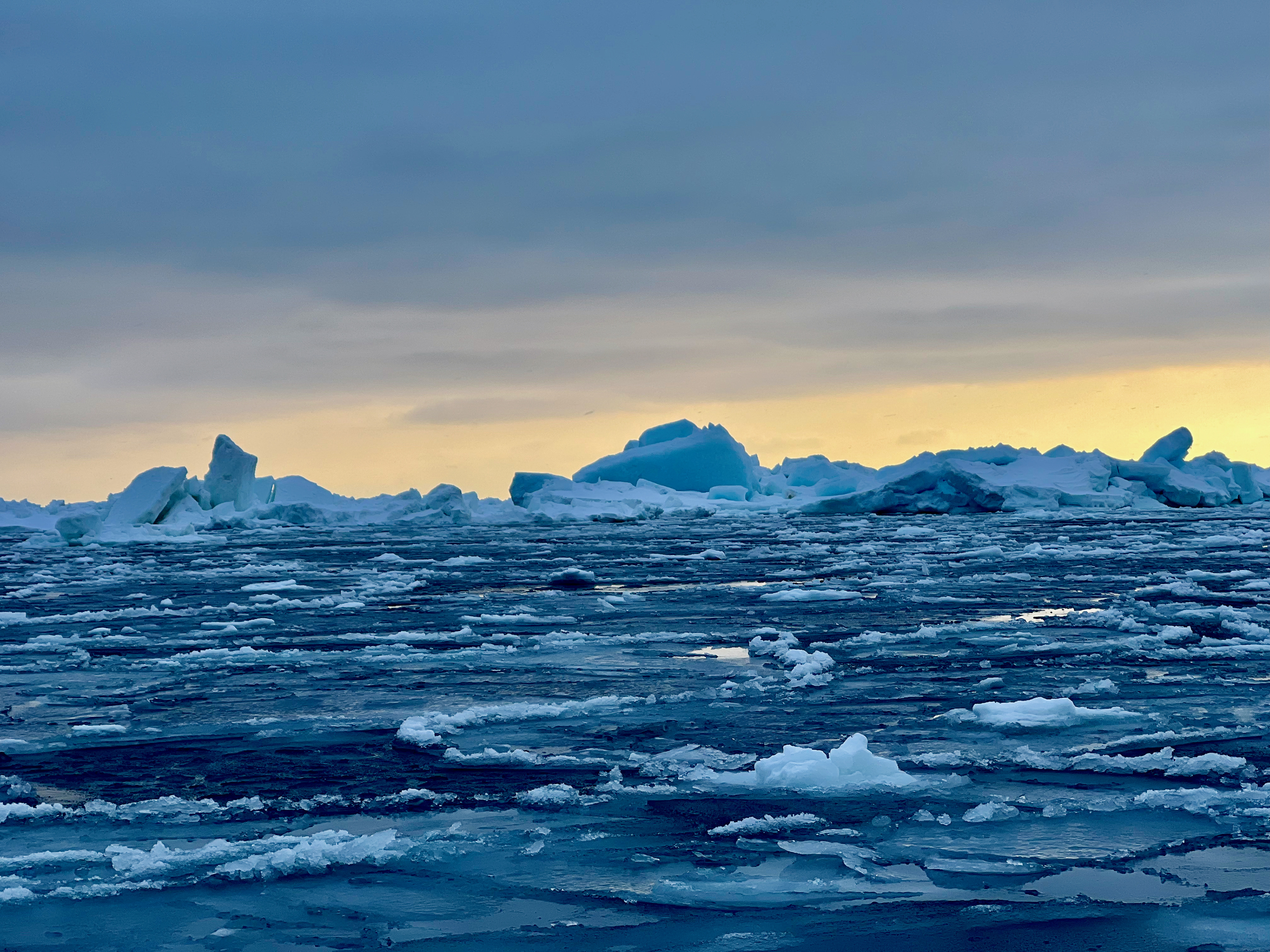

DAY 4 - THE POLAR BEAR
Upon awakening we are sailing and we are entering the Van Mijenfiord fjord to check how far the ice will allow us to arrive. We skirt the pack ice and from the deck of the boat with binoculars we see quite cool polar bear tracks. The tracks follow the coast and then we follow them to better understand the situation. The situation becomes very clear when in the distance we see the clearly recognizable shape of the bear. He is very far away but he seems intent on eating something.
We stop the ship, drop anchor, leave with the zodiacs and arrive at the closest point in front of the animal. It is still a long way off, but now we can clearly see that after eating a seal he fell asleep on ice. Obviously this is his world, this is his life and these are his times that are not connected to our great desire to see him active and to photograph him and in fact we wait, but he continues to sleep.
We therefore decide to dedicate ourselves to two walruses lying in the sun that we had previously seen not far away and that we had neglected to get to the bear quickly. With the zodiacs we come from the walruses and with the engine off we get closer and find the best shot for perspective, background and light. They are not the polar bear, but they give us shots that give us great emotion and satisfaction, until the two animals decide it's time to leave and they drop into the water, disappearing into the sea. We then decide to go back to assessing the situation from the bear to understand if he is still sleeping or if he has decided to move. We arrive in the area and with great joy we see that the bear got up and started walking along the pack ice.
And at this point begins one of those moments that sometimes last only a few seconds, sometimes even hours, but which remain forever etched in the memory of emotions.
With the zodiac we anticipate it in its presumed direction and the bear, instead of moving away and avoiding us, gets closer and closer to the sea and heads towards us. It walks frontally and gets there at close range, so much so that we back in the water with the zodiac to still respect the safety distance. He looks at us and studies us curiously and then dives and disappears underwater. We obviously retreat further to understand in which direction it will re-emerge and after a few seconds it reappears, swims a little longer in the water and then climbs back onto the ice shaking off the wet fur.
Its scientific name Ursus Maritimus means sea bear and is perfect for this animal that actually lives in and out of the water. One thing to note is that polar bears are actually black, not white. The polar bear's fur is translucent and appears white to us only due to the reflection of the light, but underneath that thick fur their skin is black.
The bear continues in the show, lies down and rolls on the ice as if it were the pet we play with and pet at home, but it is a polar bear, the most dangerous animal in the Arctic. It repeats the evolutions between ice and water several times while we admire it, fill the cards with photos and our hearts with unique emotions.
In these moments when you are so caught up in adrenaline and situations like this of taking unique photos, an important thing is to stop for a moment, raise your head, take your eyes off the camera viewfinder, do not shoot and watch the scene you are in. living in its total integrity of the setting, to fully understand the uniqueness and wonder of the moment. Every moment is unique and unrepeatable and this is more than ever. Later the photos taken will give us a great emotion every time we see them again, but the here and now of the situation can be experienced only in the very moment with the vision of everything and in this specific case with the integral vision of bear, water, ice. , mountains, with the cold that blocks your fingers, with the wind that burns your face, with the smells and sounds of the Arctic.
Wildlife photography is not just having an animal in front of the lens, but it is a unique, engaging and multisensory experience.
After more than an hour of show, the bear decides to leave and we return to the boat. Whenever you meet an animal in nature, that individual communicates with you, whether you realize it or not and this animal has communicated and transmitted an infinity of emotions to us.
We didn't even realize how long this meeting lasted, but we were out for over two hours and the uniqueness of the scene experienced and the intense emotions felt can be seen in the shining eyes, smiles and looks of everyone, when we get back to the boat and get off the zodiacs.
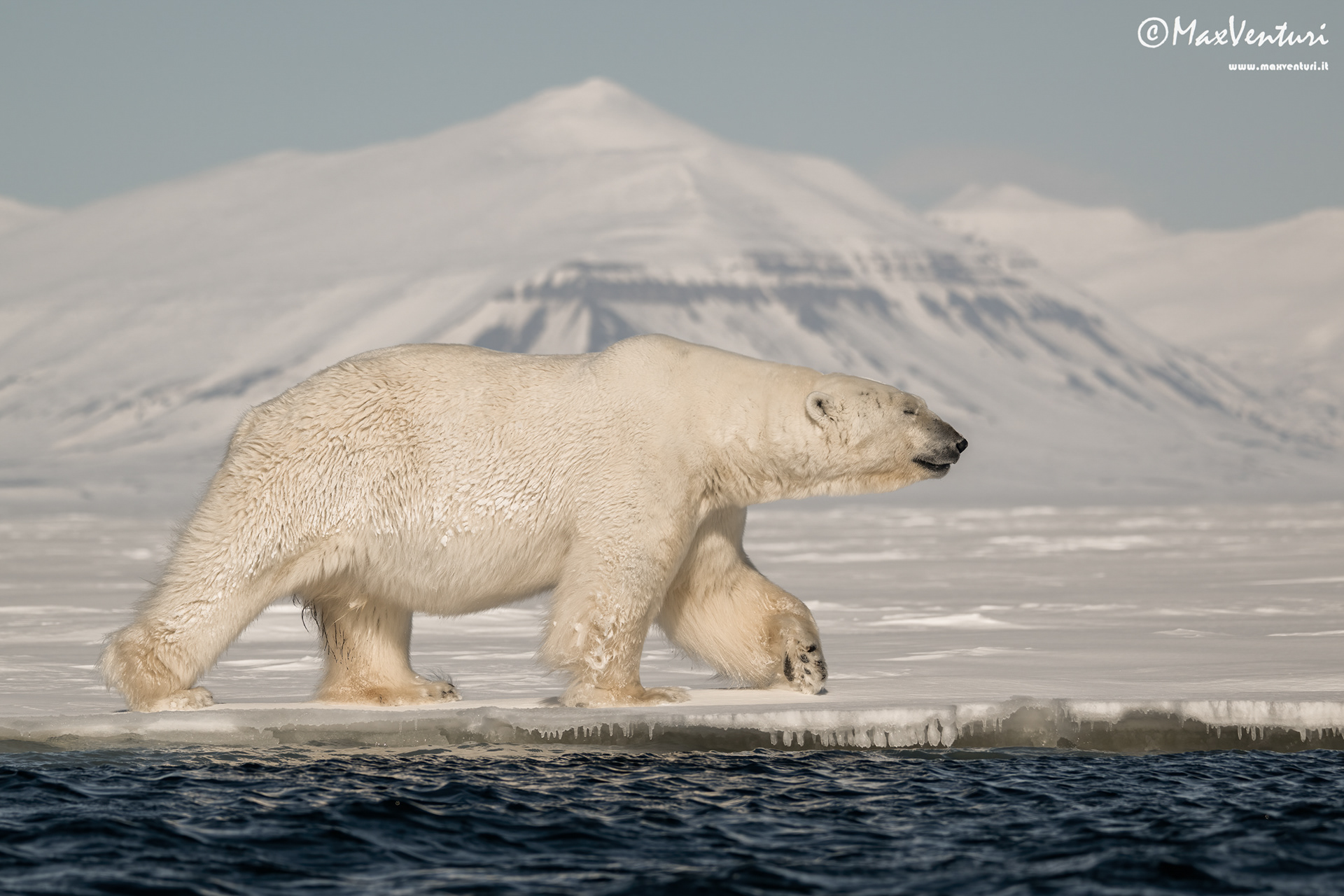





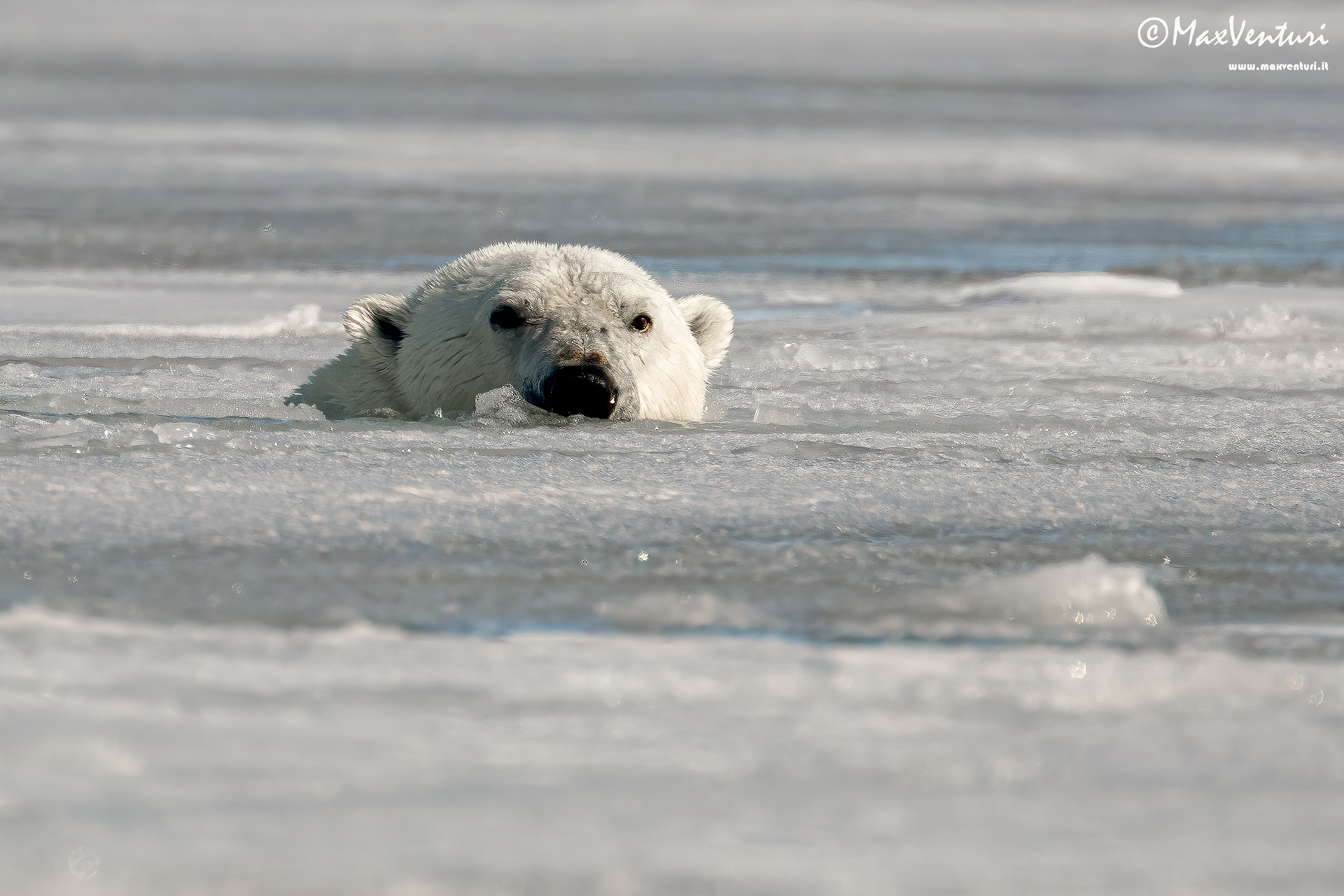

We spend a few hours on the boat to rest and recover from intense emotions and after dinner we return to excursion with the zodiacs. After a stop by a walrus lying on the ice, huge but uncooperative as it sleeps and does not move, we decide to go ashore with the aim of reaching a group of reindeer we saw from the boat. We arrive on the beach and go down for a walk on dry land in search of reindeer, with the two guides who accompany us armed with rifles. Throughout the Svalbard territory, every time you walk ashore it is absolutely mandatory to have a rifle to defend yourself from any polar bear attacks.
We then sight the group of reindeer made up of about ten specimens and we approach slowly. The Svalbard reindeer is present throughout the island and it is amazing how these animals manage to survive in lands covered with ice and snow for most of the year and find by scrabbling some frozen blades of grass to eat. It is smaller than its peers in other parts of the world; the short legs are the most vulnerable to the cold and have a temperature of only eight degrees, much lower than that of the body which is instead well covered by a light fur. The cold blood of the legs passes to the body and warms up and vice versa in a natural and continuous cycle which is essential for its survival.
The reindeer has horns that are present in both males and females, although of different shapes and sizes, and once a year they fall off and then grow back. In this period of the year the females still have horns, while the males have recently lost them and therefore lack them or have short velvet and growing shafts. We take several shots with backgrounds of mountains full of snow and ice, in a setting and light that here, as everywhere, are unique and spectacular.
To crown the moment, two ptarmigans arrive in flight and land in front of us, giving us good photo opportunities too. They still have winter white plumage, with the male following and courting the female.
As we walk back to the beach and the zodiacs we also find male reindeer poles that have recently fallen. They would certainly be a great souvenir to take home, but we leave them where we found them. They belong to Svalbard, like everything that is here, and it is right that they remain here also because they will still be useful to the soil or to some animal.
We return to the boat which is almost one in the morning with the famous midnight sun which is low and gives us wonderful lights and colors.
Today was incredible, full of sightings, encounters, emotions and photos. We get into bed physically tired, with the need to sleep to recharge our physical energies, with the intense emotions of the day still strong and impatient and ready for the wonders and emotions of tomorrow.
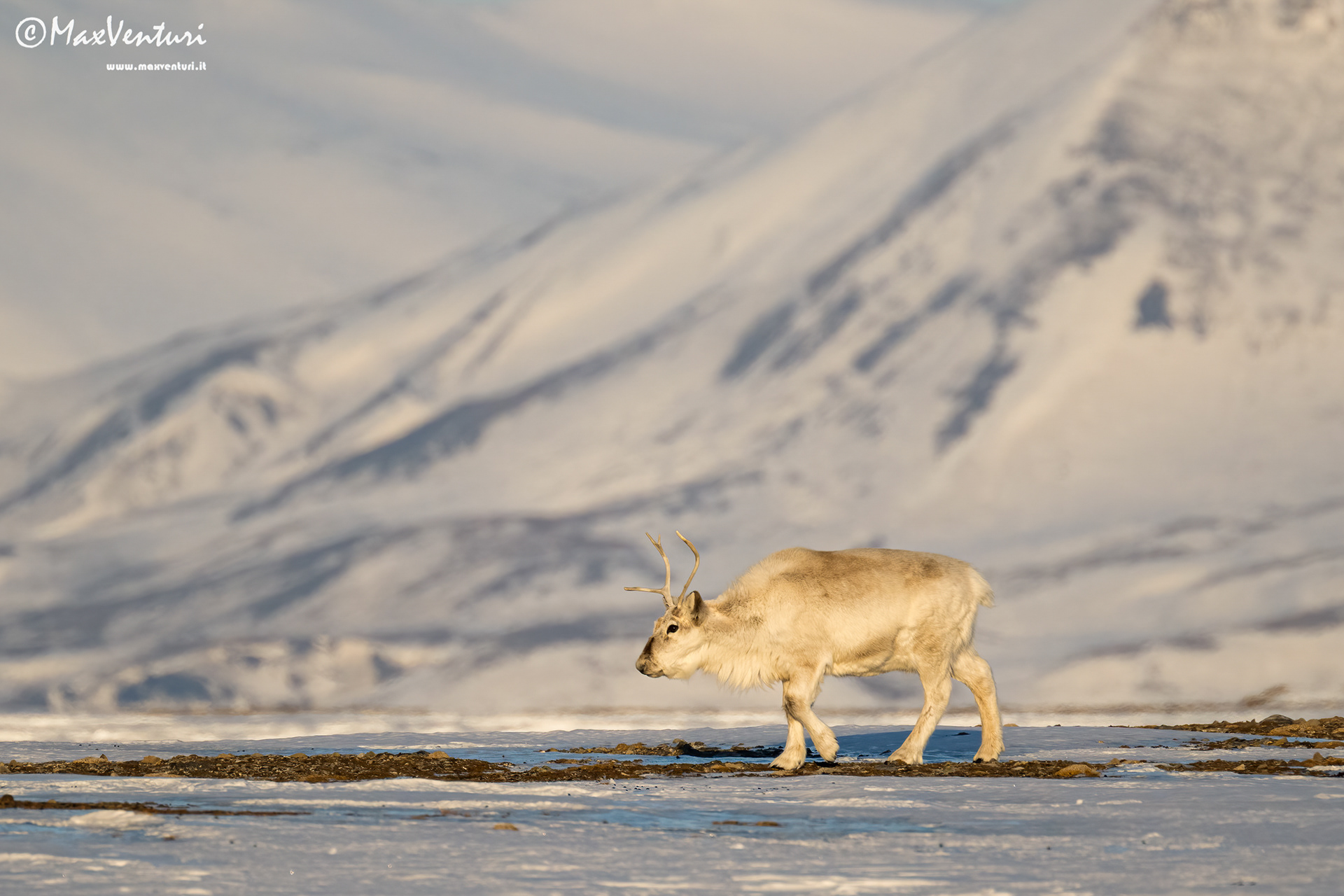
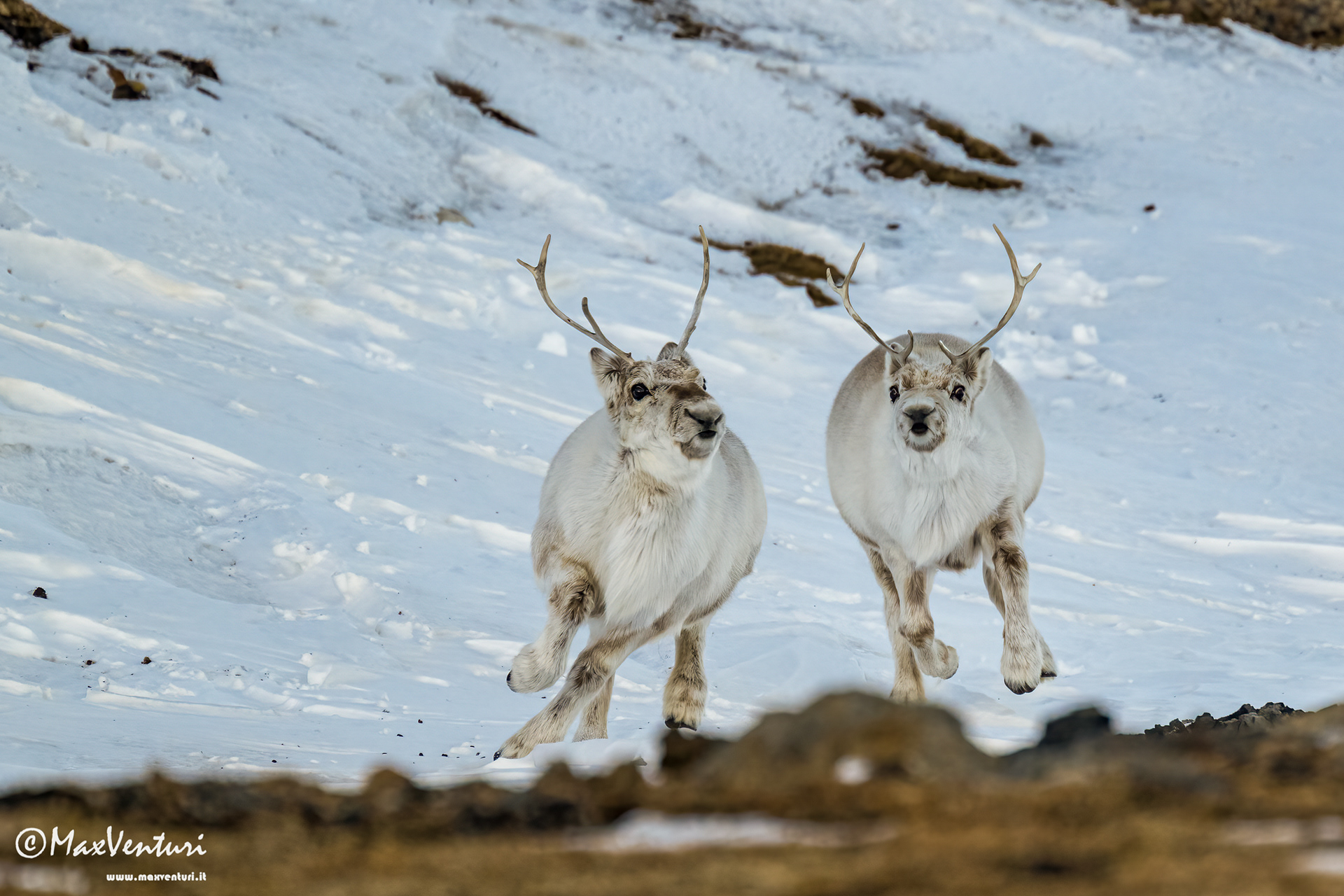

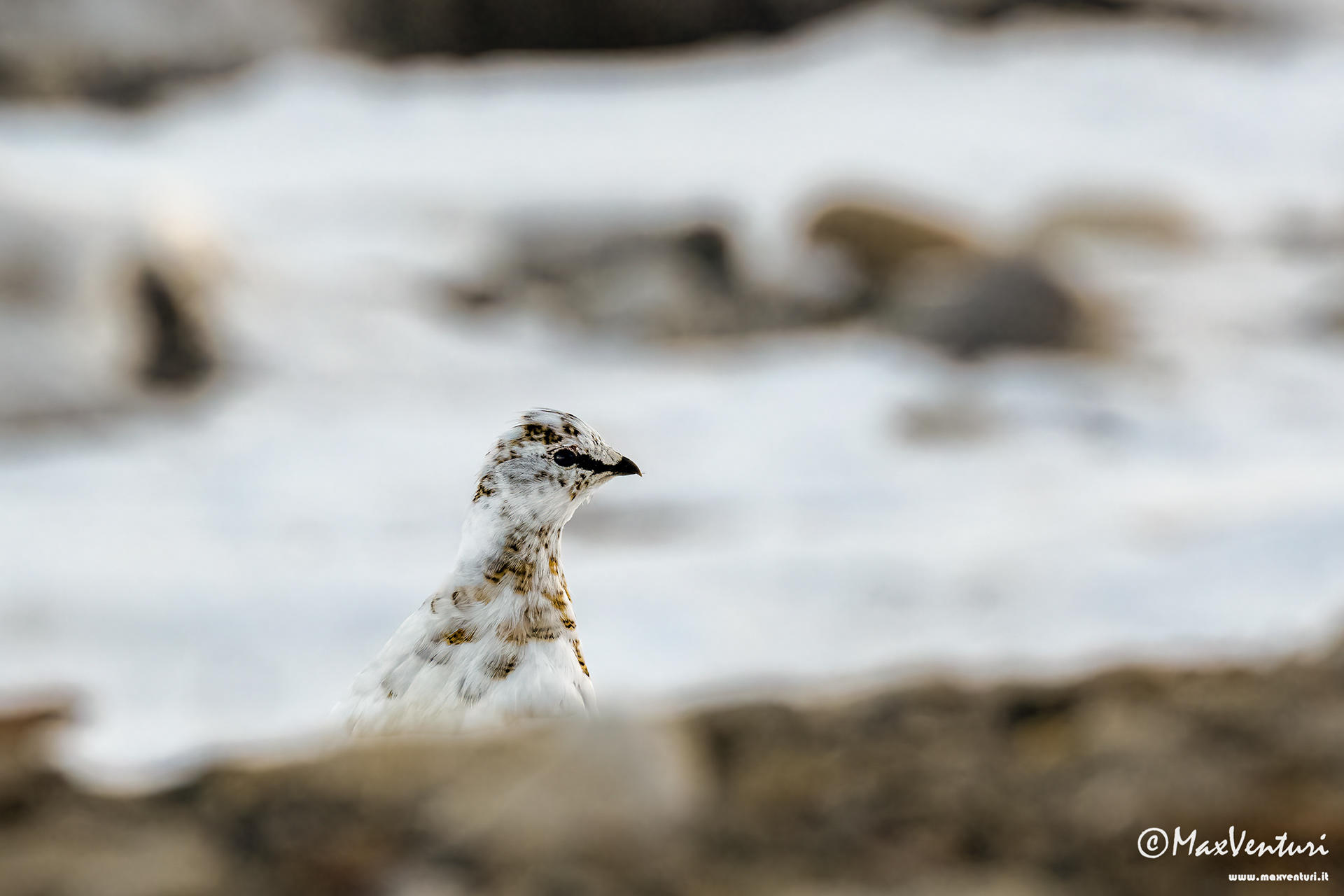

DAY 5 - THE GLACIER
We sail north towards Prins Karls Forland. After a breakfast where the euphoria of the previous day's meetings is still present, we prepare to admire the passage through the Forlandsundet canal from the boat. The morning passes in navigation, checking the landscape of the narrow and shallow channel from the bridge. At the northernmost point of the canal, the depth of the sea is only eight meters and can only be crossed at high tide and with small boats like ours. In fact, during the passage, the depth gauge on board indicates only two meters of water under our keel, paying close attention to the Captain.
After this difficult point we continue navigation; lying in the ice we meet two walruses and we have the opportunity to take some good shots from the boat thanks to the size of this boat that allows you to have a good low angle photographing directly from the outside deck. The captain stops the boat near the walruses who are watching us and lying on the deck, with the objectives stuck between the external protection grid we can immortalize them with always fabulous and unique settings and backgrounds.
We continue the navigation and we stop near another glacier. We are in Fjortende Julibreen and the day and the weather are fantastic. A beautiful sun illuminates the sea and the ice and the total absence of wind allows us to spend over three hours on a zodiac excursion without problems and difficulties. We approach and stop with the engine off under the glacier and the total silence is almost embarrassing. All you can hear is the sound of the glacier in constant and slow motion and which every now and then pours a few blocks of ice into the sea.
We go back on board the ship and after a few hours of navigation, in the late afternoon, we drop anchor in front of a majestic glacier. We will spend the night in a place that even with the imagination would be impossible to draw or imagine. The size of this glacier is truly impressive. In front of us a fifty-meter-high wall of ice that extends circularly for over a kilometer, forming a bay of turquoise water with floating icebergs of unique green and turquoise shades and with ice blocks and sheets of infinite sizes and shapes.
At this latitude, in this period of the year, the hours where the light is lowest and warmest and which photographically are called the golden hours, are those between twenty-two and two in the morning. We then decide to go down with the zodiacs for an excursion after 10 pm and we set off to navigate under the glacier in search of photographic opportunities.
In Svalbard, beauty is so present everywhere that it becomes habitual and unwittingly turns into monotony. You have to make an effort to stay focused on this beauty, but it is not always successful as traveling on the zodiacs the concentration also goes to how to keep warm with the icy wind hitting every part of your body.
Then it often happens that a minimal variation bursts to alter the monotonous and exhausting beauty of the landscape and its entrance recharges you instantly and is like a revelation. In this case it is a small seal born just a month ago that emerges from the water a few meters from the zodiac, looks at us for a few seconds and then disappears again. A quick and unique vision of those eyes that have recently begun to see the world and that for the first time see human beings. The eyes of a little seal with its entire life to be spent in the Arctic, with so many things to learn, especially the two most important things for its survival; how to get food by learning to hunt fish and how to avoid being hunted by the Arctic's largest predator, the polar bear.
We continue and we spot a walrus lying on the ice and with the usual slow approach technique and with the engine off we manage to arrive in an excellent position to take beautiful photos. All the walruses photographically always give you time and lots of opportunities, but they are not always collaborative and often sit still and lying down. This one, on the other hand, is definitely collaborative. He stands up straight, looks at us and puts himself in various different poses to give us different opportunities and situations. We spend some time with him then we go away and he goes back to sleep. Maybe we disturbed him a little, or maybe we broke his habit and monotony for a few minutes and he too was distracted and amused.
It is now one in the morning and we decide to return to the boat. As we return in front of us, the image of the boat anchored under the majesty of the glacier reveals itself to be unique and unforgettable, in a sea as smooth as oil that acts as a mirror and pours the image of the glacier and the boat itself onto the surface of the water. among the floating ices
We will spend the night and sleep here, with this image in front of our eyes and imprinted in our hearts, yet another unique and unrepeatable wonderful situation that the Arctic and Svalbard offer us on this trip.

DAY 6 - THE ARCTIC FOX
In the morning we wake up, have breakfast, spend a few more hours in this wonderful place and then we leave and resume sailing.
From the first day of navigation, some seagulls follow the boat during the navigation and can be seen flying both from the bridge and from inside from the various portholes. Surely they are different seagulls approaching, but it is nice to think that they are still the same ones who left Longyerbayen with us five days ago and who have decided to accompany us and enjoy the whole journey with us.
We enter the fjord and on the coast we see the small village of Ny-Alesund. Consisting of a dozen buildings and with a small airstrip for the summer, it serves as a base and last stop for researchers before leaving for expeditions to the North Pole. It is the first and only village seen since we left six days ago and this suggests how wild Svalbard is and completely owned by Nature.
We stop the boat in Ossian Sarsfjellet, drop anchor in front of yet another fantastic glacier and, as always, descend on the zodiacs for an excursion near the coast. The setting and landscape are fantastic as always, at first sight always the same, but instead always unique. On the coast there is a large rock face completely without ice and snow. It faces south, therefore sheltered from the cold north winds and heated by the sun all day. Here thousands of birds are nesting and laying the groundwork for their contribution to the continuation of life and their species. Mainly they are guillemots that generally live in the open sea and gather on the cliffs only for the hatching period, but also many seagulls.
While we observe this wonder with binoculars, a small white dot near a rock strikes our attention and looking closer we see a small coiled arctic fox, intent on sleeping. We decide to wait also because the wait is not complicated given the scenario we have before us. The fox, however, does not keep us waiting long and shortly after wakes up, stretches, yawns a few and starts walking on the steep wall. Arctic foxes often stay close to these walls as they have the opportunity to feed on the eggs and above all on the small chicks that will be born. They manage to do some predation even from the nest, but mainly they feed on the many chicks that in the first flight attempts fall on the rocky cliff. The fox walks among the steep rocks always quite far from us, but it is clear that it has already begun to change the thick, completely white winter fur and in some areas we already notice the presence of the dark gray summer fur.
It is beautiful to see how it moves over these dangerous rocks and above all it is fantastic to witness the wonder of the existence of new lives. In fact, when it gets close to a rock, the fox stops and two small gray balls come out of a small crack. They are the new generation of arctic foxes who will be staying in this area with their parents this year, learning how to live, and how to get food. Then in the future they will find their partners and their reef and make their contribution to the continuation of life and the species.
It's been over three hours and it's time to get back to the boat. Even today we have seen beautiful places and unique scenes. Scenes and situations that here are repeated cyclically always the same, but which instead are always unique and above all the moment in which you are the admired and amazed witness and observer of these scenes is unique.
We return to the boat, we settle down and relax with a great dinner and then tonight we go to rest early. No evening out today and the boat is already sailing towards tomorrow's destination.


DAY 7 - THE WALRUS
When we wake up we are already sailing northwards and we will arrive beyond the 80th parallel, as far as the ice will allow us, up to the north edge of the Arctic Sea, where the sea of water ends and where the great polar ice pack begins. which reaches as far as the North Pole.
The first stop of the day is in the Magdaleneafjord with the usual fantastic setting. The total absence of wind makes the sea as smooth as oil and mirrors all the mountains and ice in the area. Two walruses swim by under the boat that is dropping anchor, others can be seen near and far, lying on various blocks of ice. So let's get down on the zodiacs and go on an excursion. In addition to the normal photographic opportunities of walruses and seals on the ice, which in any case are always extraordinary for situations and settings, each outing can offer surprises and unique situations. And today the Arctic gives us hundreds of birds that move in single file resting on the surface of the water. Specifically, they are king of eiders. The male of this duck has beautiful colors and shapes and it is really rare to see so many all together. The males are in courtship, follow the females and fight each other to prove their supremacy. There is also the variant of some seagulls attacking the group, perhaps thinking that the little ones are present inside, but it is still early for the new born of the year. Movement and action, therefore, are not lacking and increase considerably when all together decide to take off in flight. They pass in front of us and turn around us, settling back in the previous position, closing a circular circle of three hundred and sixty degrees all around us. We thank them for the beautiful scene they gave us and we leave to continue with our searches in the ice.
We continue to the Smeerenbugfjord where we spot a couple of walrus mothers with their one month old baby. It is the miracle and spectacle of Nature and the arrival of new lives that are repeated every year in spring and that always brings so much emotion and joy to see it. The young walrus, which at birth already weigh sixty kg, are at great risk of being preyed upon by bears and their mothers are very alert. A baby even sits on his mother's back to feel closer and more protected. In these situations it is better not to exaggerate with distances and duration so as not to be too disturbing and not to risk defense reactions from the mother herself. We then take some shots from further away than usual and we move away leaving the mother alone with her child to teach him about life and the secrets of the Arctic.
After another couple of photo stops with walruses and seals we return to the boat where today the crew, given the anchorage location and the total absence of wind, prepared us the surprise of an outdoor table on the main deck complete with a barbecue and beers. The outdoor lunch with the breathtaking view of the wonders of the Arctic brings great euphoria and above all a lot of positive energy to everyone and we all focus and convince ourselves that between today and tomorrow, which are our last days in the Arctic, we will see a bear again polar. We have already seen and photographed it three times, but we are convinced that the circle must be closed with a last encounter with a polar bear and we are confident that the Arctic will listen to our desire.
In the late afternoon we return to the Seven Glaciers on a zodiac excursion and as always each outing is unique and different. We arrive in a bay where there are dozens of seals, some balancing and posing on stones or ice and others swimming curious around the zodiac. It almost seems that they are playing hide and seek with us; they put their heads out of the water for a few seconds, look at us and then dive again. A young seal rolls and moves madly on a sheet of ice. He may not find the right position, but he really seems to be having a lot of fun playing and rolling on the snow on the ice.
We continue and find yet another walrus lying down. We approach and turn around it to look for the background with the shades of orange and gray that the sun gives us at this time. It is a beautiful and huge specimen with long fangs of this animal that can weigh up to one thousand seven hundred kilograms. Also, this walrus surprises us and instead of lying down as is often the case with all walruses he sits up straight in the best possible position and allows us to take what will be our best walrus photo of the trip.
We return to the boat enthusiastic about this umpteenth fantastic situation that the Arctic has given us and we are even more confident for tomorrow. We will sail all night heading south and early tomorrow morning we will enter the fjord from where we left for the last day of the journey which we will devote entirely to the search for a polar bear, for the closing of the magic circle and also of our journey.





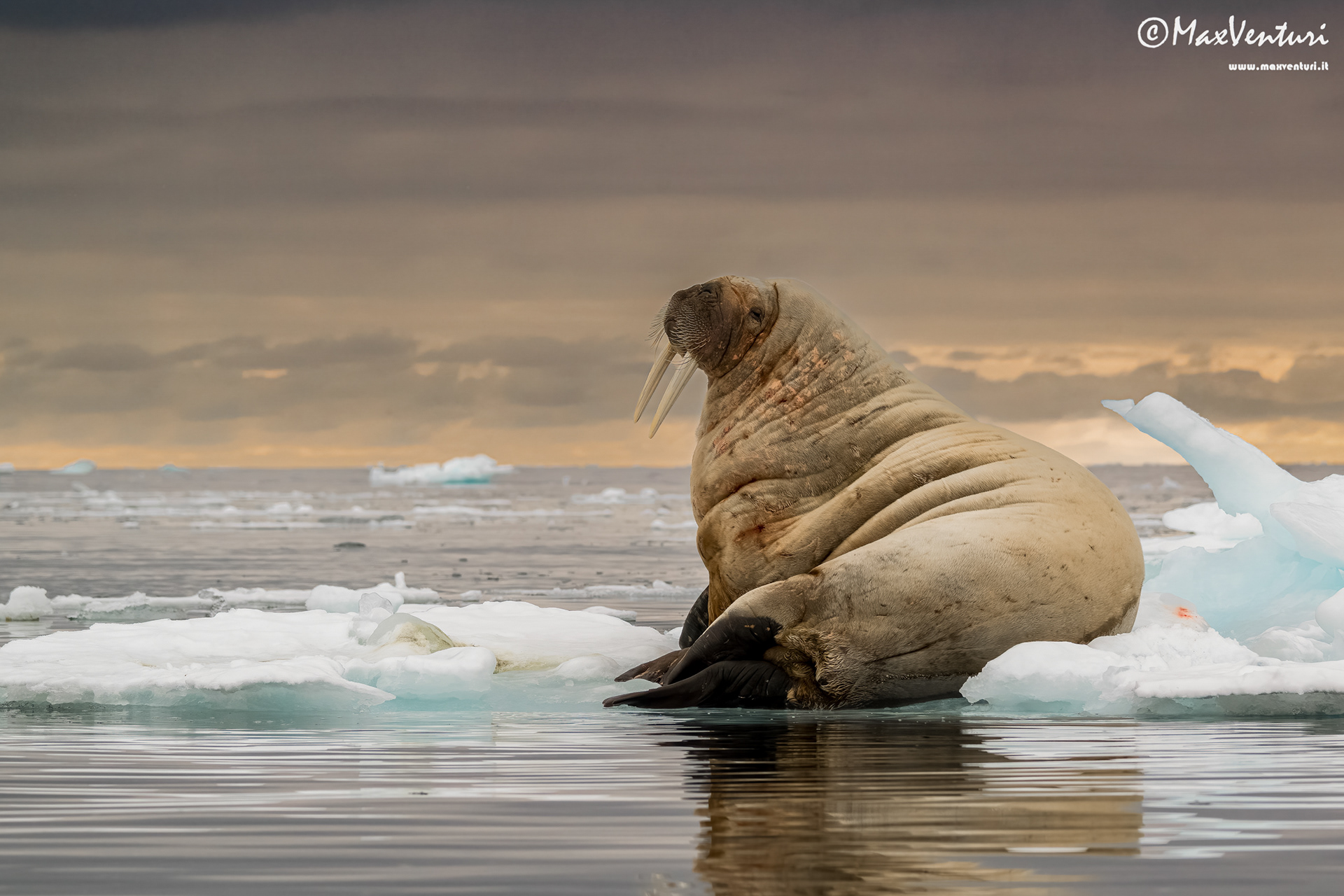
DAY 8 - THE RETURN
In the morning upon awakening, after ten hours of night sailing, we are anchored in Isfjorden where Longyerbayen is further away and from where our journey began eight days ago. Today the last full day of the Arctic awaits us, of research and excursions, of wonders and surprises.
We go out with the zodiacs immediately early in the morning, but in a couple of hours of excursion we do not find any good photographic opportunities. We also get off the zodiacs and take a short walk on the ice where we find polar bear footprints passed through here a day ago judging by the snow. No photographic opportunities or sightings, but putting the imprint of your hand next to that of the ice king's paw, knowing that he passed exactly through here, always creates that unique and magical emotion and connection.
While we return to the boat we do not miss some good photographic opportunities with some walruses and a bearded seal that has evident on her face the red color of the iron present on the Arctic seabed, where she goes to look for food. We get on board and start sailing along the coast in search of some bears.
We sail for a few hours until we notice the unmistakable shape, slightly more yellow than the snow, of a polar bear far away. It is far from the coast, but we decide to try to get as close as possible with the zodiacs. We get to the ice floe and the bear is far over there. It looks like a male on the way following an odorous trail of some female that has previously passed from there. He also passes quite close to three reindeer that as soon as they see him they run away in fear, but he barely deserves a glance and continues to walk smelling the ground. Right now he is not looking for food, but for a partner. Unfortunately, the track he follows continues towards the mountain and not towards us and soon disappears over the hill. Photographically it is not a great sighting, but the thrill of a polar bear sighting is always great and we are all happy.
From this area, with a sighting of a polar bear on the first day our adventure in the Arctic had begun and now we come full circle, with one last sighting of a polar bear on our last day in the Arctic. And here also our fantastic journey ends.
We return to Longyerbayen, we will sleep for the last night on the boat moored in the port and from tomorrow we will leave with all the necessary flights to return home.




It was a great journey, a great adventure.
Each trip is unique and offers unique emotions, but this was even more.
It was living in the Arctic isolated from everything and everyone, facing the cold wind that hits every part of your body, fighting with frozen fingers that do not allow you to push the shutter button, losing track of time and day with the sun that never sets, face the waves and the ice.
It was overcoming limits and trying to connect with this wonderful and dangerous world, which welcomes you, pampers you and envelops you with its wonders and which strikes you with its complications.
A majestic and remote world with its rules and his times, where man feels small in front of him and can only be a humble and respectful spectator and witness.
I come home with the files full of many excellent photos, but above all with all the situations experienced, the emotions I felt and the encounters made forever etched in my mind and in my heart.
I will miss the ice, I will miss the icebergs, I will miss these beautiful animals, I will miss the MV Villa, I will miss the zodiac, I will miss everything.
Even the color of the mountain overlooking Longyearbyen will remain in my mind for a long time, I'm sure ...
© MaxVenturi2022
All Rights Reserved. Any unauthorized copying, reproduction, hiring, lending, public performance and broadcasting is prohibited.
EQUIPMENT USED
Nikon Z9
Nikon Z6II
NIKKOR Z 100-400mm f / 4.5-5.6 VR S
AF-S NIKKOR 500mm f / 4E FL ED VR
AF-S NIKKOR 500mm f / 5.6E PF ED VR
TEXT
Max Venturi
PHOTOS
Max Venturi
Sonia Piatesi
PHOTOS FROM DRONE
Florian Ledoux
David Gonzales Buendia
SPECIAL THANKS
Secret Atlas Travel
Florian Ledoux
David Gonzales Buendia
Christian Bruttel
Sylvia Gross
Mv Villa's Crew
All travel companions

Max Venturi
In these moments when you are so caught up in adrenaline and situations like this of taking unique photos, an important thing is to stop for a moment, raise your head, take your eyes off the camera viewfinder, do not shoot and watch the scene you are in. living in its total integrity of the setting, to fully understand the uniqueness and wonder of the moment. Every moment is unique and unrepeatable and this is more than ever. Later the photos taken will give us a great emotion every time we see them again, but the here and now of the situation can be experienced only in the very moment with the vision of everything and in this specific case with the integral vision of bear, water, ice. , mountains, with the cold that blocks your fingers, with the wind that burns your face, with the smells and sounds of the Arctic.
Wildlife photography is not just having an animal in front of the lens, but it is a unique, engaging and multisensory experience.
WEB www.maxventuri.it
YOU TUBE maxventuri
INSTAGRAM maxventuri
FACEBOOK maxventuri65